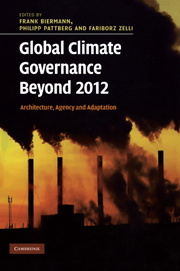Book contents
- Frontmatter
- Contents
- List of contributors
- Preface
- List of abbreviations
- 1 Global climate governance beyond 2012
- Part I Architecture
- Part II Agency
- 9 Agency in global climate governance
- 10 The role and relevance of networked climate governance
- 11 Carbon market governance beyond the public–private divide
- 12 A staged sectoral approach for climate mitigation
- 13 Technological change and the role of non-state actors
- Part III Adaptation
- Index
- References
10 - The role and relevance of networked climate governance
Published online by Cambridge University Press: 05 July 2014
- Frontmatter
- Contents
- List of contributors
- Preface
- List of abbreviations
- 1 Global climate governance beyond 2012
- Part I Architecture
- Part II Agency
- 9 Agency in global climate governance
- 10 The role and relevance of networked climate governance
- 11 Carbon market governance beyond the public–private divide
- 12 A staged sectoral approach for climate mitigation
- 13 Technological change and the role of non-state actors
- Part III Adaptation
- Index
- References
Summary
Introduction
Next to governing through markets, networks have emerged as a central steering mechanism in modern governance. Climate governance is no exception. Uncounted numbers of initiatives, projects, programmes, institutions and organizations fill the realm of global climate governance, at times targeting public actors and intergovernmental decision-making processes, while on many other occasions targeting private actors such as corporations or individuals. While it is generally acknowledged that these forms of networked governance have become more widespread and pervasive, there is rather little scholarship on their performance and broader implications (exceptions are Bäckstrand 2008; Okereke et al. 2009).
This chapter appraises different types of networked climate governance, including public non-state networks such as the C40 global cities partnership; hybrid networks emanating from public–private sources of authority such as the more than 340 partnerships that have emerged out of the 2002 World Summit on Sustainable Development (WSSD) in Johannesburg; and networks whose authority derives from purely private sources, such as corporate social responsibility and standard-setting initiatives. I appraise these different types of networked governance in the climate realm according to three sets of criteria. First, their potential contribution to effective climate change mitigation and adaptation; second, their contribution to broader political goals such as increased participation and inclusiveness in global environmental governance; and third, their linkages and fit with the existing institutional architecture of international climate change governance. The chapter concludes with a number of policy options for strengthening the contribution of networked governance mechanisms to effective climate policies.
- Type
- Chapter
- Information
- Global Climate Governance Beyond 2012Architecture, Agency and Adaptation, pp. 146 - 164Publisher: Cambridge University PressPrint publication year: 2010
References
- 4
- Cited by



